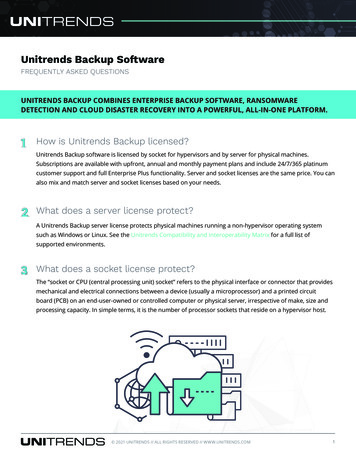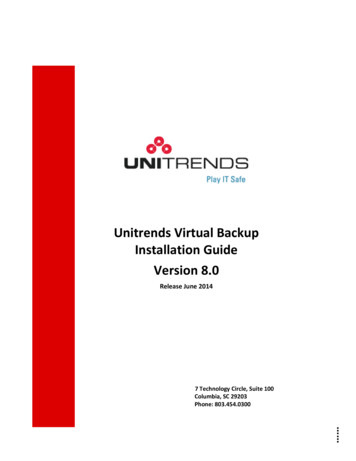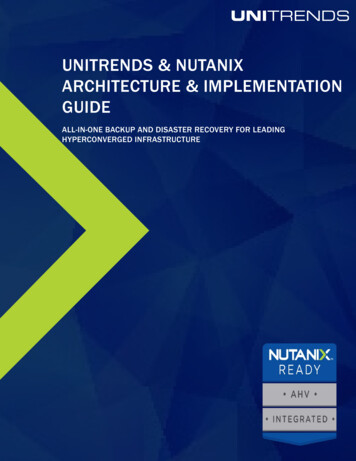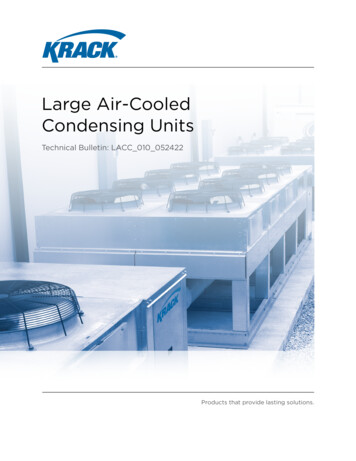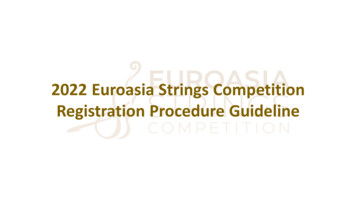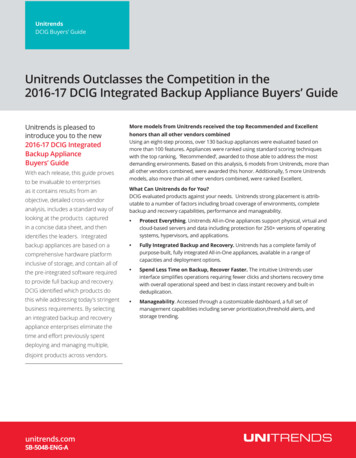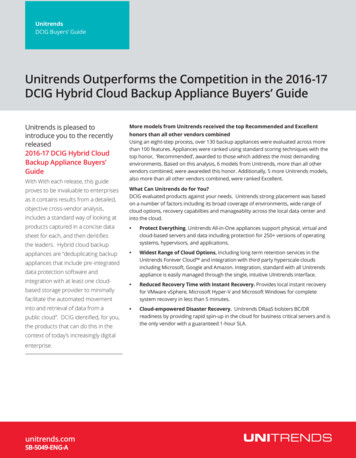
Transcription
UnitrendsDCIG Buyers’ GuideUnitrends Outperforms the Competition in the 2016-17DCIG Hybrid Cloud Backup Appliance Buyers’ GuideUnitrends is pleased tointroduce you to the recentlyreleased2016-17 DCIG Hybrid CloudBackup Appliance Buyers’GuideWith With each release, this guideMore models from Unitrends received the top Recommended and Excellenthonors than all other vendors combinedUsing an eight-step process, over 130 backup appliances were evaluated across morethan 100 features. Appliances were ranked using standard scoring techniques with thetop honor, ‘Recommended’, awarded to those which address the most demandingenvironments. Based on this analysis, 6 models from Unitrends, more than all othervendors combined, were awareded this honor. Additionally, 5 more Unitrends models,also more than all other vendors combined, were ranked Excellent.includes a standard way of looking atWhat Can Unitrends do for You?DCIG evaluated products against your needs. Unitrends strong placement was basedon a number of factors including its broad coverage of environments, wide range ofcloud options, recovery capabilties and manageablity across the local data center andinto the cloud.products captured in a concise data Protect Everything. Unitrends All-in-One appliances support physical, virtual andcloud-based servers and data including protection for 250 versions of operatingsystems, hypervisors, and applications. Widest Range of Cloud Options. Including long term retention services in theUnitrends Forever Cloud and integration with third party hyperscale cloudsincluding Microsoft, Google and Amazon. Integration, standard with all Unitrendsappliance is easily managed through the single, intuitive UInitrends interface. Reduced Recovery Time with Instant Recovery. Provides local instant recoveryfor VMware vSphere, Microsoft Hyper-V and Microsoft Windows for completesystem recovery in less than 5 minutes. Cloud-empowered Disaster Recovery. Unitrends DRaaS bolsters BC/DRreadiness by providing rapid spin-up in the cloud for business critical servers and isthe only vendor with a guaranteed 1-hour SLA.proves to be invaluable to enterprisesas it contains results from a detailed,objective cross-vendor analysis,sheet for each, and then dentifiesthe leaders. Hybrid cloud backupappliances are “deduplicating backupappliances that include pre-integrateddata protection software andintegration with at least one cloudbased storage provider to minimallyfacilitate the automated movementinto and retrieval of data from apublic cloud”. DCIG identified, for you,the products that can do this in thecontext of today’s increasingly digitalenterprise.unitrends.comSB-5049-ENG-A
The Insider’s Guide to EvaluatingHybrid Cloud Backup Appliances2016-17HYBRID CLOUD BACKUPAPPLIANCE BUYER’S GUIDEBy Charley McMaster and Ben MaasE M P O W E R I N G T H E I T I N D U S T R Y W I T H A C T I O N A B L E A N A LY S I S · W W W. D C I G . C O M
2016-17 HYBRID CLOUD BACKUP APPLIANCE BUYER’S GUIDEThe Insider’s Guide to Evaluating Hybrid Cloud Backup AppliancesTable of Contents1Introduction4Executive Summary6How to Use this DCIG 2016-17 Hybrid CloudBackup Appliance Buyer’s Guide6Disclosures7Inclusion and Exclusion Criteria7The Eight-Step Process Usedto Rank Products8DCIG Comments889910101111111212DCIG Observations & Recommendations1213141416Feature Consolidation in the Purpose BuiltBackup Appliance MarketHybrid Cloud Backup Appliance Use CasesThe Role of Virtual MachinesPublic Cloud vs Proprietary CloudVirtual and Physical Restore CapabilitiesNetwork OptimizationBulk Data TransfersGeographical SeparationComplying with Regulatory RequirementsPerformance and PricingGeneral ObservationsRecommended RankingExcellent RankingGood RankingHybrid Cloud Backup ApplianceBuyer’s Guide Rankings18Hybrid Cloud Backup ApplianceBuyer’s Guide Products19Cohesity C230020Cohesity C250021CommVault A21022CommVault A41023CommVault A60024Quorum onQ-280-3225Quorum onQ-288-3226STORServer A740-CV27STORServer A740-TSM28STORServer EBA 2802-CV29STORServer EBA 2802-TSM30Unitrends Recovery 60331Unitrends Recovery 60432Unitrends Recovery 713S33Unitrends Recovery 714S34Unitrends Recovery 814S35Unitrends Recovery 824S36Unitrends Recovery 933S37Unitrends Recovery 936S38Unitrends Recovery 943S39Unitrends Recovery 944S40Unitrends Recovery 946S41Veritas NetBackup 5240AppendicesA-1 Appendix A—Definitions, Explanations and TerminologyB-1 Appendix B—Vendor Contact InformationC-1 Appendix C—DCIG Contact InformationThis Buyer’s Guide Edition is licensed to Unitrends with unlimited and unrestricted distribution rights through October 31, 2017. 2016 DCIG, LLC. All rights reserved.i
2016-17 HYBRID CLOUD BACKUP APPLIANCE BUYER’S GUIDEThe Insider’s Guide to Evaluating Hybrid Cloud Backup AppliancesIntroductionπάντα χωρεῖ καὶ οὐδὲν μένειHeraclitus of Ephesus, c. 535 BC – 475 BC“Everything changes and nothing stands still.” This ancient saying of Heraclitus rings true intoday’s information technology industry—including the data protection industry.The purpose-built backup appliance market is dynamic. In the months since DCIGpublished the inaugural DCIG 2015-16 Hybrid Cloud Backup Appliance Buyer’s Guide: New vendors have entered the market Existing vendors have introduced new products based on more powerful hardware;delivering more performance and capacity to keep up with ever growing enterprise dataprotection requirements Vendors have released new software features to provide more benefits to end users,blurring the boundaries between traditional product categoriesThe purpose-built backup appliance market is growing. This is part of an ongoing shifttoward pre-integrated appliance-based solutions that can be rapidly deployed into theenterprise data center through largely non-disruptive plug-and-play installations. In fact,according to IDC, worldwide purpose-built backup appliance (PBBA) factory revenues grew11.5% year over year, and capacity shipped increased 35.3% to 1EB since 2Q15.1Ever-increasing data volumes, driven by the growth in both structured and unstructureddata, strain corporate backup abilities and create a need for new solutions. While otherbackup and data optimization technologies offer some relief, PBBA’s have become the goto solution.DCIG evaluates PBBA products based on three primary use cases: Deduplicating backup appliances are sometimes referred to as “Backup TargetAppliances”. These appliances displace legacy backup targets; integrating into existingdata protection schemes. Their optimized deduplication technologies reduce backupstorage consumption by up to 20x while accelerating the backup process. Theseappliances typically work with a variety of backup applications, though some productsonly integrate with the provider’s own data protection software. Integrated backup appliances (IBA) are deduplicating backup appliances that includepre-integrated data protection software. They displace both legacy backup targets andlegacy backup software. In the integrated backup appliance use case backup data maybe replicated to another location but the data remains entirely within the custody of thecorporation behind the corporate firewall. Hybrid cloud backup appliances (HCBA) are deduplicating backup appliances thatinclude pre-integrated data protection software and integration with at least onecloud-based storage provider to minimally facilitate the automated movement andretrieval of data from a public cloud storage provider. The cloud provider’s capabilitiesmay extend to include full restorations and the running of the organization’s applicationsat the cloud provider’s data center. An HCBA’s ability to replicate backups to the cloudsupports disaster recovery needs and provides essentially infinite storage capacity.“Worldwide Purpose-Built Backup Appliance (PBBA) Market . - IDC.” 2016. 29 Sep. 2016 https://www.idc.com/getdoc.jsp?containerId prUS41628016 This Buyer’s Guide Edition is licensed to Unitrends with unlimited and unrestricted distribution rights through October 31, 2017. 2016 DCIG, LLC. All rights reserved.1
2016-17 HYBRID CLOUD BACKUP APPLIANCE BUYER’S GUIDEThe Insider’s Guide to Evaluating Hybrid Cloud Backup AppliancesIntroduction(continued)As core business processes become digitized, the ability to keep services online and torapidly recover from any service interruption becomes a critical need. Given the growth andmaturation of cloud services, many organizations are exploring the advantages of storingtheir application data with cloud providers and even recovering applications in the cloud.Special hybrid cloud backup considerations. Organizations need to apply some additionalcriteria when evaluating hybrid cloud backup appliances; as more factors come into play thanwith other PBBA’s. For instance, organizations are advised to spend time validating: The HCBA’s interoperability with the various cloud providers and what additionalfunctionality they support beyond just copying data to the cloud, if any Available bandwidth and the cost of this bandwidth to a specific cloud provider Bulk data transfer options to quickly establish a fully protected data environment andaccelerate disaster recoveryOrganizations that have outgrown the capabilities of their legacy backup solutions willdiscover a large number of vendors and products vying to become their next generation solution. Thoroughly researching the many available products has become too timeconsuming and costly to be feasible for many organizations. The DCIG 2016-17 HybridCloud Backup Appliance Buyer’s Guide solves this problem. This Buyer’s Guide evaluatesthe full range of PBBA product capabilities, including features that enable the long-termretention of backups in the cloud and even application recovery in the cloud.DCIG’s analysts have already done the heavy lifting for enterprise technology buyers by: Identifying a common technology need with many competing solutions but with littlecomparative data available to technology purchasers Scanning the environment to identify available products in the marketplace Gathering normalized data about the features each product supports Providing an objective, third-party evaluation of those features froman end-user perspective Describing key product considerations and important changes in the marketplace Presenting DCIG’s opinions and product feature data in a way that facilitates rapidfeature-based comparisonsThe Value This DCIG Buyer’s Guide Creates for BuyersIt is in this context that DCIG presents its 2016-17 Hybrid Cloud Backup Appliance Buyer’sGuide. The level of detail in this Buyer’s Guide, combined with DCIG’s consistent ranking system, helps organizations in two key ways: First, it provides a powerful yet concisemethod to evaluate each product so organizations can understand the overall strengthsand weaknesses of each one. Using this information, evaluators can better align thespecific needs of their environment with the features available on each appliance.Second, this Buyer’s Guide provides a concise one-page data sheet for each product. Thedata sheets drill down into the specifics of each product to provide information on virtualization, management, backup and recovery, replication cloud management, hardware andsupport features. These feature areas contribute the overall ranking for each product.This Buyer’s Guide Edition is licensed to Unitrends with unlimited and unrestricted distribution rights through October 31, 2017. 2016 DCIG, LLC. All rights reserved.2
2016-17 HYBRID CLOUD BACKUP APPLIANCE BUYER’S GUIDEThe Insider’s Guide to Evaluating Hybrid Cloud Backup AppliancesIntroduction(continued)The DCIG 2016-17 Hybrid Cloud Backup Appliance Buyer’s Guide is based on a pool of morethan 130 products in DCIG’s Backup Appliance Body of Research. DCIG analysts ranked hybridcloud backup appliances based on an evaluation of more than 100 different features. Thetwenty-three (23) appliances from six (6) vendors that met the inclusion criteria and achieved aranking of Recommended, Excellent or Good are included in this Buyer’s Guide.Please note that this Buyer’s Guide is NOT intended to be a substitute for internal testing. DCIG encourages any organization that is considering the purchase of a hybrid cloudbackup solution to do its own in-house testing if at all possible as it is impossible for DCIGto predict how well the appliance will perform in every environment.We hope this Buyer’s Guide meets its intended purposes in your environments and servesas a helpful aid in supplementing and expediting your organization’s normal decisionmaking and product evaluation process.As a supplement to the downloadable Buyer’s Guide, end users registering to access thisreport via the DCIG Analysis Portal also gain access to the DCIG Interactive Buyer’s Guide(IBG). The IBG enables organizations take the next step in the product selection processby generating custom reports, including comprehensive side-by-side feature comparisonsof the products in which the organization is most interested. See portal.dcig.com to learnmore about the DCIG Analysis Portal.Charley and BenThis Buyer’s Guide Edition is licensed to Unitrends with unlimited and unrestricted distribution rights through October 31, 2017. 2016 DCIG, LLC. All rights reserved.3
2016-17 HYBRID CLOUD BACKUP APPLIANCE BUYER’S GUIDEThe Insider’s Guide to Evaluating Hybrid Cloud Backup AppliancesExecutiveSummaryHybrid cloud backup appliances have emerged as a leading solution to incorporate cloudservices into an organization’s backup and disaster recovery plans. The DCIG 2016-17Hybrid Cloud Backup Appliance Buyer’s Guide gives organizations insights into thisimportant market segment.Hybrid cloud backup appliances offer many benefits to organizations. Using these solutions, companies can more easily backup and recover applications on premise. Then,once the application data is initially protected, it may be replicated off-site.Once the data is in the cloud, a number of hybrid cloud backup appliances give organizations new options for recovery. For example, a number of these solutions may host virtualmachines (VMs) either on the appliance or in the cloud with the cloud provider to doapplication recoveries.Hybrid cloud backup appliances now offer sufficiently robust hardware and software tomeet the data protection requirements of almost any size organization. The hybrid cloudmodel introduces, for the practical purposes of most organizations, the concept of an infinite cloud-based storage pool for backup data storage and application recovery purposes.The support of one or more cloud providers by hybrid cloud backup appliances makesthem a one-stop shop that potentially offers both onsite and offsite backup and recovery.The regulatory environment around data storage and security has become increasinglystringent and more complex. National laws and industry-specific regulations abound, especially with regard to personally identifiable information (PII). Thus financial, governmentaland healthcare organizations may be understandably reluctant to store or recover private,sensitive information in the cloud.Increased clarity about industry regulations, coupled with the maturation of cloud technology itself, may enable more organizations to confidently move ahead with their adoptionof hybrid cloud backup appliances. Nevertheless, it is incumbent on each organization tomatch its regulatory data management requirements to cloud storage provider(s) certified capabilities. It is for these reasons that DCIG encourages organizations to thoroughlyresearch their data privacy and retention requirements when selecting a hybrid cloudbackup appliance and cloud provider.Beyond understanding the regulatory environment, the greatest challenge now facing organizations may be sorting through the dozens of models available on the market to identifythe right size model with the right options for their environment.This is where the distinctions between appliances become critical. While their differencesmay be technical and maybe even seemingly minor on the surface, they can have a significant impact upon the success an organization experiences when using a hybrid cloudbackup appliance in its environment. This is why DCIG evaluated more than 100 featureson each product, including support for multiple hypervisors and cloud providers.It is in this context that DCIG presents the DCIG 2016-17 Hybrid Cloud Backup ApplianceBuyer’s Guide. As prior DCIG Buyer’s Guides have done, it puts at the fingertips of organizations a resource that provides them with a comprehensive list of hybrid cloud backupappliances that can assist them in this important buying decision while removing muchof the mystery around how these appliances are configured and which ones are suitablefor which purposes.This Buyer’s Guide Edition is licensed to Unitrends with unlimited and unrestricted distribution rights through October 31, 2017. 2016 DCIG, LLC. All rights reserved.4
2016-17 HYBRID CLOUD BACKUP APPLIANCE BUYER’S GUIDEThe Insider’s Guide to Evaluating Hybrid Cloud Backup AppliancesExecutive Summary(continued)Executive SummaryThis 2016-17 Hybrid Cloud Backup Appliance Buyer’s Guide accomplishes the(continued)following objectives: Provides an objective, third-party evaluation of products that evaluatesand ranks their features from an end user’s viewpoint Includes recommendations on how to best use this Buyer’s Guideand the products contained in it Evaluates the features of each product based upon criteria that matter mostso end users can quickly know which appliance is most appropriate for them Provides a standardized data sheet for each product so end users can do quickcomparisons of the features supported and not supported on each product Gives any organization the ability to request competitive bids from different providersThis Buyer’s Guide Edition is licensed to Unitrends with unlimited and unrestricted distribution rights through October 31, 2017. 2016 DCIG, LLC. All rights reserved.5
2016-17 HYBRID CLOUD BACKUP APPLIANCE BUYER’S GUIDEThe Insider’s Guide to Evaluating Hybrid Cloud Backup AppliancesHow to Use this DCIG 2016-17 HybridCloud Backup Appliance Buyer’s GuideThis Buyer’s Guide is intended to help users accelerate theirproduct research and selection process—driving cost outof the research process while simultaneously increasingconfidence in the results. The purpose of this Buyer’s Guideis NOT to tell users exactly which product(s) to purchase.Rather, it is to help guide them in coming up with a short listof competitive products that have comparable features thatmeet their specific needs.Just because a product ranks well does not automatically mean that it is the right product for an organization. Ifanything, because of the scope of the products evaluatedand analyzed, it may have features that are too robust forthe needs of an individual department or organization.However, this Buyer’s Guide does give organizations somesense of how each product compares to other productscovered in this Guide, as well as offers additional insightinto what product offerings are available on the market.DCIG recommends that companies use this Buyer’s Guidein the following seven ways:1. Eliminate the painstaking research normally associated with identifying a short list of products thatmeet their needs. DCIG analysts dug through productweb sites, reports and product manuals to uncover morethan 100 features supported by the twenty-three (23)products from six (6) vendors in this Buyer’s Guide. Aglance at the resulting ranking sheet reveals howcomplete the features of each product are compared tothe other products. A look at the corresponding datasheet reveals whether or not a product supports thefeatures required to make it onto a particular organization’s short list for further consideration.Sometimes it is very difficult for an organization toknow if it is truly getting a good deal when bids comein from vendors that include different products. Noworganizations can refer to the rankings of each producton this guide so they know when they are getting agood deal, a great deal or just a “so-so” one.4. Gain perspective on how products from lesswell-known vendors compare against establishedand better-known brands. There’s a built-in level ofcomfort when buying products from well-knownvendors. There’s also a built-in resistance to buyingproducts from vendors that are perceived as unknownquantities. This Buyer’s Guide helps to remove some ofthat apprehension. Using this Buyer’s Guide, organizations can see how these products stack up.5. Normalize complex terminology. Every industry hasa proclivity to adopt acronyms and jargon that isspecific to it. This Buyer’s Guide sifts through theacronyms and jargon and then normalizes these terms,providing a foundation for meaningful comparisons.Definitions for these normalized terms are provided inthe Glossary in this Guide.6. Take advantage of standardized data sheets toquickly compare products side-by-side. Theproduct data sheets available from the differentvendors are rarely laid out in the same way or containthe same information. Some vendors even have datasheet formats that vary from product to product withintheir own portfolio. This Buyer’s Guide tackles thisproblem by creating a standard, easy-to-read datasheet for every product. In this way, product datasheets for individual products can be printed out andlaid down side by side so that the features on themcan be quickly compared.7. Help justify buying recommendations to businessteams. An overall ranking of Recommended, Excellent orGood is included at the top of every product data sheet.This overall ranking summarizes in a single word howfeature rich a product is compared to the other productsin the Buyer’s Guide.2. Do apples-to-apples comparisons of products fromdifferent vendors. It behooves an organization to getcompetitive bids from multiple vendors. After all, whenthey compete, you win! But that tactic only works wellwhen organizations know that they are receivingcompetitive bids on products that are roughly comparable. Using this Buyer’s Guide, organizations can do abetter job of accomplishing that objective.Disclosures3. Separate the apples from the oranges. Just asimportant as doing apples-to-apples comparisons isidentifying when an orange is thrown into the mix.Over the last few years the general trend in the US hasbeen for both large and boutique analyst firms to receivesome or all of their revenue from vendors.This Buyer’s Guide Edition is licensed to Unitrends with unlimited and unrestricted distribution rights through October 31, 2017. 2016 DCIG, LLC. All rights reserved.6
2016-17 HYBRID CLOUD BACKUP APPLIANCE BUYER’S GUIDEThe Insider’s Guide to Evaluating Hybrid Cloud Backup AppliancesDCIG is no different in this respect as it also receivespayment for the different services it performs for vendors.The services that DCIG provides include blogging,customer validations, product reviews, executive whitepapers, special reports and white papers. Must be available as a physical applianceIn the interest of transparency, a number of the vendorsincluded in this DCIG Buyer’s Guide are or have been DCIGclients. This is not to imply that their products were givenpreferential treatment in the Buyer’s Guide. All it means is thatDCIG had more knowledge of their products so that DCIGcould consider their product for inclusion in this Buyer’s Guide. Enables connectivity with at least one cloud-basedstorage provider for remote backups and long-termretention of backups in a secure/encrypted fashionIn that vein, there are a number of important facts to keepin mind when considering the information contained in thisBuyer’s Guide and its merit. Provides the ability to connect the cloud-basedbackup images on more than one geographicallydispersed appliance May also ship as a virtual appliance Stores backup data on the appliance via on premiseDAS, NAS or SAN-attached storage Offers multiple layers of storage efficiency(deduplication/compression) and high availability(multiple controllers/nodes) No vendor paid DCIG any fee to research this topicor arrive at pre-determined conclusions. Includes backup and recovery software that enablesseamless integration into an existing infrastructure DCIG did not guarantee any vendor that its productwould be included in this Buyer’s Guide Includes support for standard application level backups(Exchange, Oracle, MSSQL, Sharepoint, etc.) DCIG did not imply or guarantee that a specific productwould receive a preferential ranking in this Buyer’s Guide,before or after completion of research Sufficient information provided to reachmeaningful conclusions All research was based upon publicly available information, information provided by the vendor, and/or theexpertise of those evaluating the information No negative inferences can be drawn against anyvendor not included in the Buyer’s Guide It is a misuse of the Buyer’s Guide to make comparisonsbetween any vendor not ranked in the Buyer’s Guide.Because of the number of features analyzed and weighed,there was no way for DCIG to accurately predict at the outsethow individual products would end up ranking. DCIG wantsto emphasize that no vendor was privy to how DCIG weighedindividual features. In every case the vendor only found out therankings of its product(s) after the analysis was complete.Inclusion and Exclusion CriteriaThe DCIG 2016-17 Hybrid Cloud Backup ApplianceBuyer’s Guide is based on DCIG’s Backup Appliance Bodyof Research on more than 130 backup appliances. Thefollowing criteria were used when determining whether ornot to include as a specific hybrid cloud backup appliancein this Buyer’s Guide: It must be generally available on July 1, 2016.The Eight-Step Process Usedto Rank ProductsTo rank each product included in this Buyer’s Guide, DCIGwent through an eight-step process to come to the mostobjective conclusion possible.1. DCIG established which features would be evaluatedand which ones would not. Prior to selecting thefeatures which would be evaluated, DCIG quantified,then “normalized” the list of available features such thata common name for each feature was established. Incases where a feature could not be objectively definedor understood, it was excluded from consideration.2. The features were grouped into six (6) general categories. The features to be evaluated were grouped intofour broad categories: Virtualization, Management,Backup & Recovery, Replication Cloud Management,Hardware and Support.3. DCIG completed a survey for each vendor’s product(s)and then sent the survey(s) to each vendor for verification. Each vendor was invited to review theirThis Buyer’s Guide Edition is licensed to Unitrends with unlimited and unrestricted distribution rights through October 31, 2017. 2016 DCIG, LLC. All rights reserved.7
2016-17 HYBRID CLOUD BACKUP APPLIANCE BUYER’S GUIDEThe Insider’s Guide to Evaluating Hybrid Cloud Backup Appliancesdata and respond with any corrections or edits to theDCIG-completed survey(s). In every case, every vendorhad the opportunity to review and respond to anyDCIG-completed survey.4. DCIG identified a list of products that met the DCIGdefinition for “Hybrid Cloud Backup Appliance” basedon the inclusion/exclusion criteria.5. DCIG weighted each feature to establish a scoring rubric.The weighting of each feature was done by a team ofDCIG research analysts. The weightings were used toreflect if a feature was supported and potentially howuseful and/or important the feature was to end users.6. Each product’s features were scored based oninformation gathered in the surveys. Features weremarked as either “supported” or “unsupported/undetermined” and then scored accordingly. Rankingswere finalized after any updates from vendors had beenentered and the review period expired.7. Products were ranked using standard scoring techniques. One of the goals of this Buyer’s Guide is toestablish clear lines of differentiation with conclusionsthat are arrived at objectively. To accomplish this goal,the mean or average score for all products was firstdetermined and then the standard deviation. DCIGdeveloped an overall ranking for each product basedon where that product’s overall score fit into standarddeviation ranges.8. Product data sheets were created and sent to thevendors for review before publication. Each data sheetincluded in this published version of the Buyer’s Guidewas sent to the vendors prior to publication for theirreview and feedback. In every case, each vendor had anopportunity to review and update the content includedon its respective data sheet(s).Due to the large number of product features that DCIG evaluated, only a subset of the collected data could be includedon the data sheets. The feature data on the data sheets wasselected based on the following criteria: 1) the most variability,2) the greatest scoring weight, and 3) of the greatest interestto prospective array purchasers. The full set of product featuredata may be accessed in the DCIG Analysis Portal availablethrough DCIG’s website: www.dcig.com.DCIG CommentsFeature Consolidation in the Purpose BuiltBackup Appliance MarketIt was just last year that the inaugural DCIG 2015-16Hybrid Cloud Backup Appliance Buyer’s Guide wasreleased. It was created to reflect the segmentation in thecloud backup market into two major use cases. For usebehind corporate firewalls, DCIG evaluates the features ofPBBA’s with pre-integrated data protection software in itsIntegrated Backup Appliance Buyer’s Guides. For use inconjunction with public cloud providers, DCIG evaluates thefeatures of PBBA’s with pre-integrated data protection software in its Hybrid Cloud Backup Appliance Buyer’s Guides.Careful observers will note that several of the appliancesin this guide appear in other DCIG Buyer’s Guides. Thisis a reflection on the versatility of this class of p
data protection schemes. Their optimized deduplication technologies reduce backup storage consumption by up to 20x while accelerating the backup process. These appliances typically work with a variety of backup applications, though some products only integrate with the provider's own data protection software.


